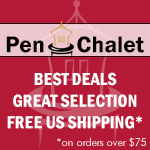(Jeff Abbott is a regular contributor at The Pen Addict. You can find more from Jeff online at Draft Evolution and Twitter.)
It's been a while since we gave the Kuru Toga some love around here, but that's going to change with the Roulette. This pencil has been around for quite some time, but it can be easy to overlook given the sheer number of mechanical pencil options that exist today. What sets the Roulette apart from the regular Kuru Toga, you ask? Knurling.
As opposed to the all-plastic construction of the regular Kuru Toga, the Roulette has a metal section with knurled grip. It's a nice feature, and definitely improves the writing experience of the pencil. At just a few bucks more than the regular Kuru Toga, it's a great upgrade. The knurled grip adds a lot of stability when holding the pencil, and the cool metal feels better in the hand compared to the plastic grip of the regular Kuru Toga.
Underneath the metal exterior is the namesake of this pencil — the lead rotation mechanism that made the Kuru Toga famous. As you write, the lead rotates a millimeter every time you lift the lead off the paper. This ingenious design means you are always writing with perfectly rounded lead instead of ending up with sharp angled edges. With most pencils, you're probably used to rotating the pencil a bit once one side of the lead gets too dull. That creates a sharp contrast to the small edge that the fresh lead creates. With the Kuru Toga mechanism, you can enjoy a consistent line width since it's constantly rotating as you write.
This feature isn't a gimmick, either. It works flawlessly. The only case in which this lead rotation action doesn't work well is if you're making long, continuous strokes with the pencil instead of writing. It's not a good drafting pencil, but it's great for writing notes, doing math homework, and keeping handy around the house.
Even though the knurled metal grip adds a touch of class to this pencil, there were some compromises made in order to keep the price low. Aside from the grip, the rest of the pencil is made of plastic and painted to mimic metal. They actually did a great job with this effect, as it can be difficult to pick out the plastic bits, but it's really obvious once you pick it up and start handling it. Even though this is a compromise, they've executed it very well, and it also keeps the cost down so the pencil is very accessible.
The clip on the pencil is removable and is very strong. Once you clip this pencil to something, it's not going to come loose on accident. As with most mechanical pencils, there's also a tiny eraser under the click cap, which is also where you can add more lead.
Speaking of lead, this pencil is only available in the 0.5mm variety, which is a bit disappointing. I'd love to see some 0.3mm and 0.7mm options as well. You can find those sizes in the regular model of Kuru Toga, so I'm a bit perplexed by the omission in this premium line. Aside from the silver featured here, you can also pick up a gun metallic variant.
As an added bonus, the grip section features a small round window that shows the internal lead rotation mechanism as it rotates round and round. If you hold the pencil just right, you can see the rotation as you write.
I've always been a big fan of the Kuru Toga because of how well it works. What sounds like a gimmick is actually a great feature that Uni executed perfectly. The addition of the metal knurled grip is fantastic, drawing comparisons to much more expensive pencils and improving the grip dramatically. At just under $12, these pencils are affordable and provide an excellent value. Definitely worth having one in your arsenal!
(JetPens provided this product at no charge to The Pen Addict for review purposes.)
Enjoy reading The Pen Addict? Then consider becoming a member to receive additional weekly content, giveaways, and discounts in The Pen Addict shop. Plus, you support me and the site directly, for which I am very grateful.
Membership starts at just $5/month, with a discounted annual option available. To find out more about membership click here and join us!




















